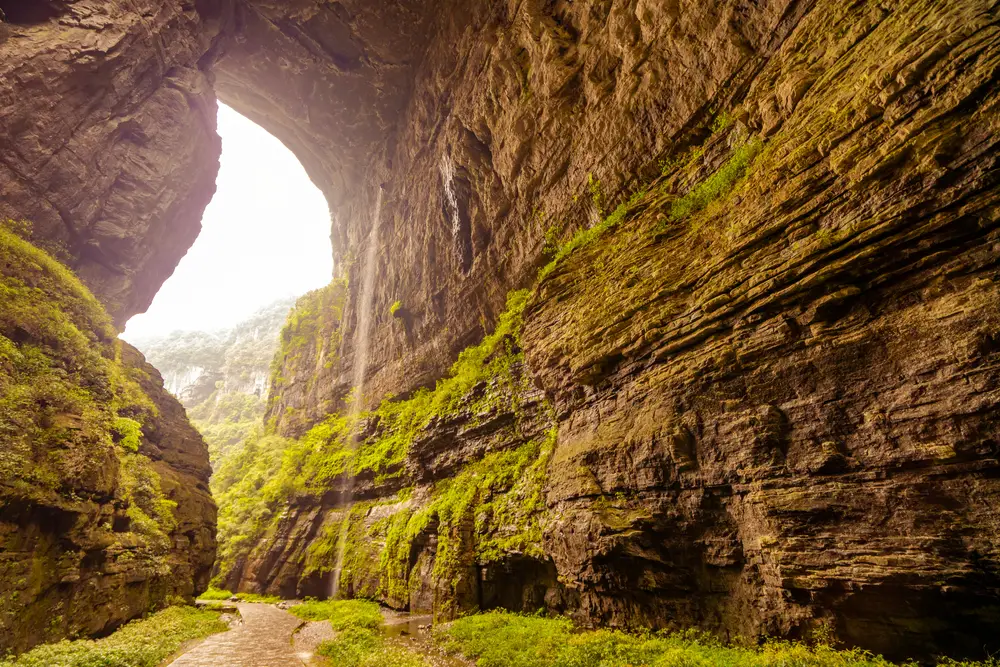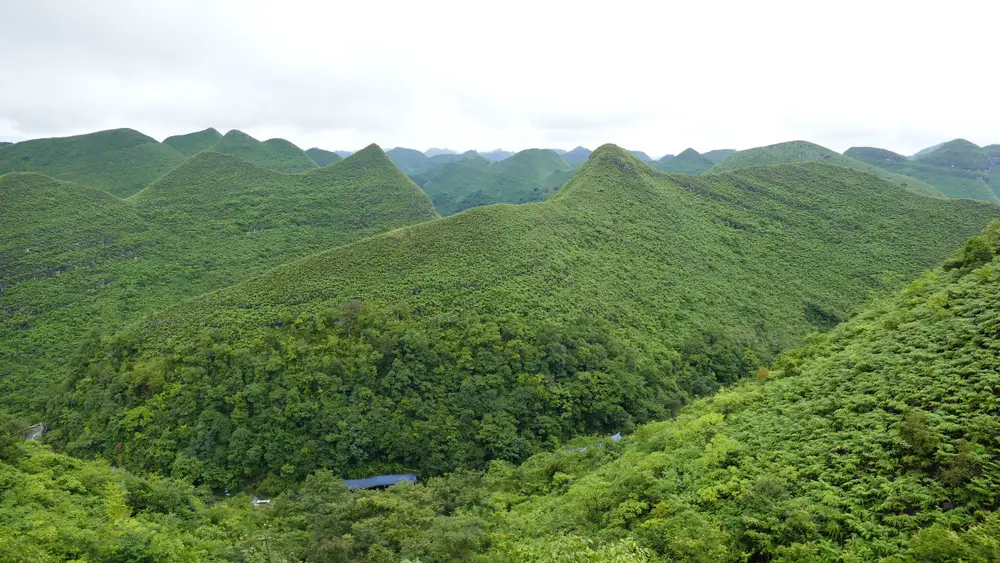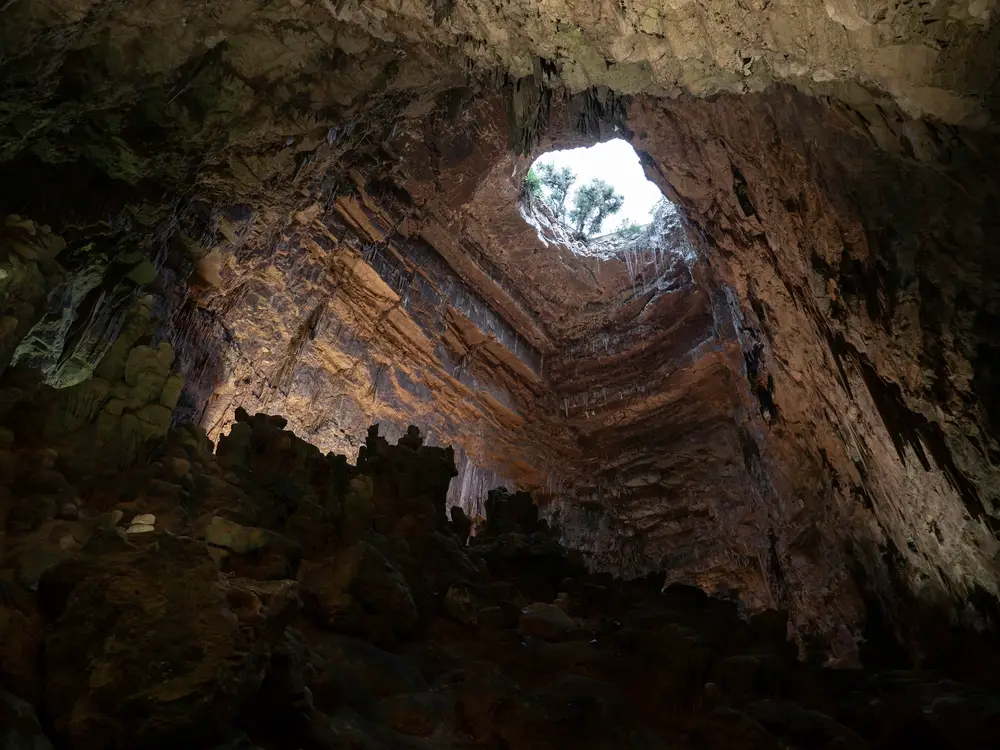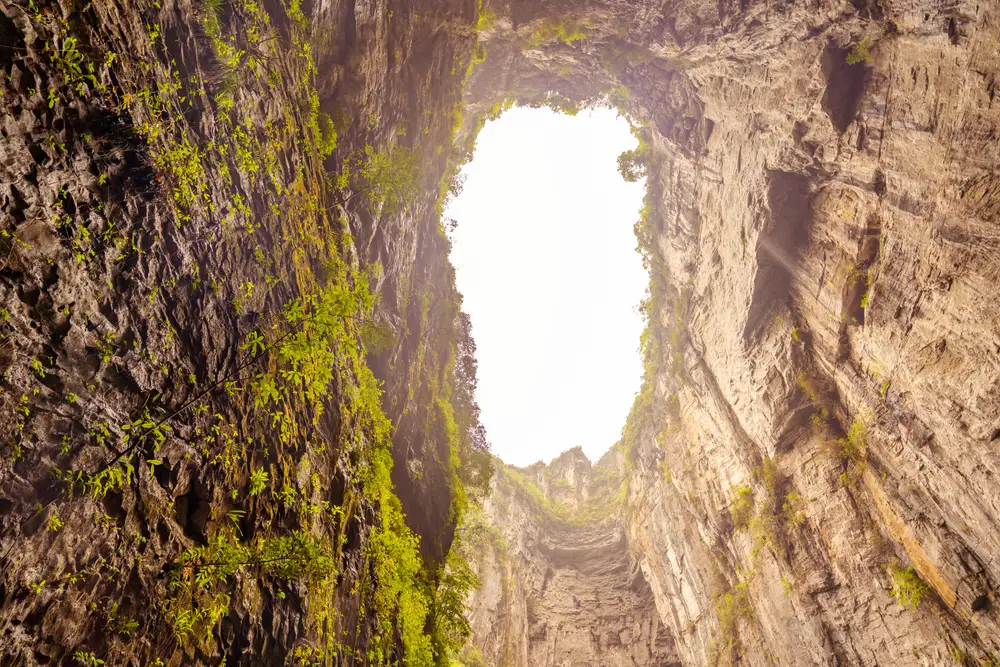A remarkable discovery has unveiled an extraordinary ecosystem within a recently found sinkhole in Guangxi Zhuang Autonomous Region’s Leye County, China. This cavernous wonder, measuring a staggering 1,004 feet in length, 492 feet in width, and plunging 630 feet into the depths, has captivated scientists with its thriving ancient plants and towering trees. The find, made on May 6 by intrepid cave explorers, not only showcases the resilience of life in unexpected places but also raises the tantalizing possibility of encountering previously unknown species in this subterranean realm.
The Sinkhole’s Dimensions and Discovery

The enormity of the sinkhole discovered in Guangxi Zhuang Autonomous Region’s Leye County transcends the ordinary, opening a gateway to uncharted realms beneath the Earth’s surface. With a length measuring a staggering 1,004 feet and a width spanning 492 feet, this geological marvel stands as a testament to the sheer force of natural processes that shape our planet. The vast expanse of the sinkhole, coupled with its considerable depth of 630 feet, sets the stage for an extraordinary scientific exploration into the mysteries concealed within its cavernous depths.
A Gateway to the Unknown: Three Cave Entrances
The sinkhole’s significance amplifies with the revelation of not one but three cave entrances beckoning explorers into the subterranean labyrinth. Each entrance becomes a portal to a hidden world, promising scientific revelations and the potential discovery of species previously unknown to science. The triad of entrances adds complexity to the exploration, offering diverse entry points for scientists to navigate and unveil the secrets concealed within the sinkhole’s intricate network of chambers and passageways.
Anticipation and Discovery: Chen Lixin’s Leadership
At the forefront of this scientific endeavor is Chen Lixin, the leader of the expedition, whose vision and anticipation underscore the significance of this discovery. Lixin’s leadership becomes pivotal as the expedition team prepares to delve into the unknown, armed with curiosity and a fervent desire to unravel the mysteries hidden within the sinkhole’s depths. His role as the expedition’s guide adds a human element to the scientific pursuit, emphasizing the collaborative effort required to comprehend the complexities of Earth’s subterranean landscapes.
Unveiling Unknown Species: A Scientific Odyssey
Chen Lixin’s expressed anticipation hints at the possibility of encountering species that have eluded scientific scrutiny. The sinkhole, with its unique ecological conditions, becomes a potential haven for biodiversity, fostering the growth and evolution of species yet to be cataloged by the scientific community. Lixin’s leadership takes on added significance as the expedition transforms into a scientific odyssey, promising not only the exploration of physical dimensions but also the unveiling of biological diversity thriving in this hidden ecosystem.
Towering Giants: The Unique Ecosystem Within
The sinkhole’s forest, a captivating feature within this subterranean landscape, introduces a mesmerizing spectacle of life adapting to unexpected conditions. Towering trees, some reaching nearly 130 feet in height, defy the conventional expectations of what one might find in the depths of a sinkhole. The unique ecosystem nurtured within this cavernous space challenges preconceived notions, highlighting the resilience of life in the face of extreme and unconventional environments.
Ecosystem Uniqueness: Adapting to Subterranean Realms

The towering trees within the sinkhole’s forest become emblematic of the ecosystem’s unparalleled uniqueness. As scientists prepare to explore this hidden world, they are poised to investigate the adaptive strategies employed by these ancient plants to thrive in conditions vastly different from their surface counterparts. The subterranean realm, with its towering giants, becomes a living laboratory for ecological studies, offering insights into the intricacies of life beneath the Earth’s surface.
Setting the Stage: A Journey into Subterranean Mysteries
The dimensions of the sinkhole, coupled with the anticipation of discovering unknown species and the towering trees within its forest, collectively set the stage for an extraordinary journey into the mysteries of Earth’s subterranean landscapes. As scientists embark on this exploration, guided by Chen Lixin’s leadership, the sinkhole becomes not just a geological wonder but a living testament to the resilience, adaptability, and diversity of life in unexpected corners of our planet.
The Role of Karst Terrain in Sinkhole Formation
The formation of sinkholes, a geological spectacle that captivates the imagination, is intricately woven into the fabric of the Earth’s crust. At the heart of this phenomenon lies the geological marvel known as Karst terrain, a landscape characterized by the dissolution of bedrock. George Veni, distinguished as the executive director of the National Cave and Karst Research Institute, offers invaluable insights into the symbiotic relationship between Karst and the creation of visually striking sinkholes and cave entrances.
Karst: Nature’s Dissolving Canvas
Karst, a term derived from the Kras Plateau in Slovenia, serves as a geological canvas where nature unfolds its dissolving artistry. The bedrock, often composed of soluble rocks like limestone, undergoes a transformative journey initiated by the interaction of rainwater with the Earth’s surface. This process sets the stage for the creation of sinkholes, a manifestation of the intricate dance between water and rock that shapes the subterranean landscapes.
China’s Karst Extravaganza: A Visual Symphony
George Veni’s elucidation shines a spotlight on China’s exceptional contribution to the world of Karst formations. The country’s topography, adorned with immense karst structures, offers a visual symphony of dramatic sinkholes and awe-inspiring cave entrances. The unique geological conditions of China’s karst terrain provide an ideal breeding ground for the birth of these subterranean wonders, each a testament to the dynamic interplay of geological forces.
A Tapestry of Sinkholes and Caves: China’s Unique Topography
China’s karst formations stand as a testament to the unparalleled diversity and grandeur of Earth’s geological features. The country’s unique topography, featuring expansive karst landscapes, contributes to the creation of sinkholes that vary in size, shape, and complexity. From expansive sinkholes that resemble natural amphitheaters to intricate cave entrances beckoning explorers into the subterranean unknown, China’s karst topography paints a diverse and mesmerizing tapestry of geological wonders.
The Karst Process: Unraveling the Underground Drama

George Veni’s expertise allows us to delve into the intricate processes that define the evolution of Karst landscapes and the subsequent formation of sinkholes. The journey begins with the interaction of rainwater with the Earth’s surface, a seemingly mundane occurrence that sets in motion a symphony of dissolution. As rainwater descends, it absorbs carbon dioxide, transforming into a mildly acidic solution capable of eroding the soluble bedrock.
From Rainwater to Acidic Solution: The Transformation Unveiled
The transformation of rainwater into an acidic solution marks a pivotal stage in the Karst process. This solution, now enriched with carbon dioxide, infiltrates the ground, making its way through soil and fractures in the bedrock. With each percolation, the solution progressively dissolves the minerals within the bedrock, creating voids and channels beneath the Earth’s surface. This gradual dissolution unfolds over geologic timescales, shaping the subterranean landscape in ways that continually intrigue scientists and explorers.
Subterranean Voids: The Birth of Chambers and Tunnels
The culmination of the Karst process manifests as the once-solid bedrock transforms into a labyrinth of subterranean voids, chambers, and tunnels. The acidic solution, having tirelessly carved its path through the bedrock, leaves behind a network of interconnected spaces. These voids, concealed beneath the surface, become the foundations for the extraordinary sinkholes that punctuate landscapes like China’s karst terrain.
Ceiling Collapse: The Emergence of Sinkholes
The narrative reaches its climax with the inevitable consequence of the Karst process – the collapse of the ceiling above the subterranean voids. The lack of support, a consequence of continuous dissolution and erosion, results in the formation of sinkholes. These geological marvels, with their diverse shapes and sizes, emerge as surface expressions of the intricate processes transpiring beneath. China’s karst terrain, blessed with this geological symphony, bears witness to the birth of sinkholes that dot its landscapes in a testament to the enduring dance between water and rock.
Southern China’s Karst Topography: A Geological Marvel
Veni’s lack of surprise at the discovery stems from his awareness of Southern China’s immense karst topography. The region’s landscape is a canvas painted with mesmerizing sinkholes, caves, and other geological formations. The sheer scale of these features makes them difficult to notice in other parts of the world. Southern China, however, stands as a testament to the dramatic impact of karst processes, offering a canvas for nature’s grand artistic expression.
China’s Sinkhole Panorama: A Glimpse into the Subterranean Realm
China boasts the world’s largest sinkhole, and the recent discovery adds another captivating chapter to the country’s sinkhole panorama. The newfound sinkhole in Guangxi Zhuang Autonomous Region marks the 30th in the region, each with its unique characteristics and ecological surprises. Notably, Xiaozhai Tiankeng holds the title of the world’s largest sinkhole, boasting dimensions of 1760 feet in width, 2100 feet in depth, and 2000 feet in length. Its grandeur is further accentuated by the presence of a waterfall within its colossal confines.
Exploring the Subterranean Ecosystem: A Scientific Odyssey
The recent revelation of a sinkhole in Guangxi Zhuang Autonomous Region’s Leye County beckons scientists to embark on a scientific odyssey into the enigmatic world concealed beneath the Earth’s surface. This subterranean ecosystem, teeming with ancient plants and towering trees, presents an unparalleled opportunity for exploration. The allure of the unknown propels the scientific community towards unraveling the intricacies of life in unexpected corners of our planet.
Biodiversity in the Abyss: An Uncharted Frontier
As researchers prepare to delve into this hidden world, the prospect of encountering unprecedented biodiversity looms large. The sinkhole’s unique ecological conditions, shielded from the harsh surface elements, create a haven for adaptations and evolution. The scientific odyssey promises to unveil a plethora of species, potentially new to science, adapting to the subterranean challenges. Questions surrounding the intricate web of life, the strategies of survival, and the possibility of discovering new species tantalize the scientific imagination, setting the stage for a groundbreaking exploration.
The Resilience of Ancient Flora: Thriving Against the Odds
The presence of ancient plants and towering trees within the subterranean ecosystem captivates researchers with the resilience exhibited against the odds. These botanical survivors, shielded from the conventional sunlight and weather patterns, offer a unique insight into the adaptability of life in extreme environments. Scientists eagerly anticipate studying the physiological and ecological strategies employed by these ancient flora, unraveling the secrets that have allowed them to thrive in the depths of the sinkhole, far removed from the familiar conditions of the Earth’s surface.
Beyond the Veil: Lingering Questions
As the scientific community stands on the precipice of this underground odyssey, lingering questions punctuate the excitement. The pursuit of knowledge extends beyond the discovery itself, delving into the intricacies of the subterranean ecosystem. Researchers grapple with questions about the interconnectedness of species, the ecological dynamics at play, and the potential symbiotic relationships that sustain life in this hidden realm. The journey into the sinkhole becomes not just a physical exploration but a quest for understanding the delicate balance that characterizes life beneath the Earth’s surface.
Conservation and Preservation: Balancing Exploration and Responsibility
With the thrill of discovery comes an inherent responsibility – the preservation of fragile ecosystems nestled within the sinkhole’s depths. The delicate balance between scientific exploration and environmental conservation takes center stage as researchers navigate the unique challenges posed by subterranean environments. With its ecological significance, the sinkhole becomes a microcosm of Earth’s intricate ecosystems, warranting careful consideration and a commitment to responsible exploration practices.
Sustainable Exploration Practices: Ensuring Longevity
The ecological weight carried by the newfound sinkhole amplifies the importance of sustainable exploration practices. Scientists recognize the imperative to minimize the ecological footprint while unraveling the mysteries of this hidden ecosystem. The adoption of ethical and sustainable exploration methodologies becomes paramount, ensuring that the delicate balance of life within the sinkhole remains undisturbed. By prioritizing the longevity of these remarkable ecosystems, researchers pledge to tread lightly, leaving minimal impact while extracting maximum knowledge.
A Collaborative Effort: Balancing Curiosity and Conservation
Conservation and exploration need not be mutually exclusive; rather, they intertwine in a delicate dance of understanding and preservation. Researchers acknowledge the symbiotic relationship between curiosity-driven exploration and the responsibility to protect Earth’s hidden wonders. Collaboration among scientists, environmentalists, and conservationists becomes crucial in striking the right balance. By fostering a collective commitment to conservation ethics, the scientific community endeavors to ensure that the newfound sinkhole remains an enduring testament to the marvels of Earth’s subterranean ecosystems.
A Subterranean Symphony of Life
The discovery of an entire ecosystem thriving within a sinkhole in China serves as a testament to the resilience and adaptability of life on Earth. As scientists embark on a journey to unravel the mysteries concealed in the depths of this geological marvel, the world eagerly awaits revelations about the diverse array of species and adaptations that have evolved in this subterranean sanctuary. The sinkhole stands not only as a testament to the intricate processes shaping our planet but also as an invitation for humanity to marvel at the wonders that continue to unfold beneath the surface.
Sources:
The sinkhole, with its unique ecological conditions, becomes a potential haven for biodiversity.
China’s exceptional contribution to the world of Karst formations.
This subterranean ecosystem, teeming with ancient plants and towering trees.
With its ecological significance, the sinkhole becomes a microcosm.
This Site Was Inspired By An Interest in Protecting the Environment
We had the privilege and joy of learning from Dr. Charlie Stine who instilled a love for the natural world through incredible field trips with the Johns Hopkins Odyssey Certificate program in Environmental Studies. At the time, the program was endorsed by the Maryland Department of Natural Resources. Sadly, after Dr. Stine retired, the program was phased out. We hope that we honor his legacy by shining a bright light on environmental issues and sharing good news about the success of various conservation programs when possible.

